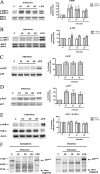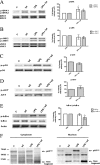Activation of phosphatidylinositol 3-kinase/Akt and impairment of nuclear factor-kappaB: molecular mechanisms behind the arrested maturation/activation state of Leishmania infantum-infected dendritic cells
- PMID: 21037075
- PMCID: PMC2993270
- DOI: 10.2353/ajpath.2010.100367
Activation of phosphatidylinositol 3-kinase/Akt and impairment of nuclear factor-kappaB: molecular mechanisms behind the arrested maturation/activation state of Leishmania infantum-infected dendritic cells
Abstract
Understanding the complex interactions between Leishmania and dendritic cells (DCs) is central to the modulation of the outcome of this infection, given that an effective immune response against Leishmania is dependent on the successful activation and maturation of DCs. We report here that Leishmania infantum promastigotes successfully infect mouse bone marrow-derived DCs without triggering maturation, as shown by a failure in the up-regulation of CD40 and CD86 expression, and that parasites strongly counteract the lipopolysaccharide-triggered maturation of DCs. A small increase in interleukin (IL)-12 and IL-10 transcription and secretion and a decrease in IL-6 were observed in infected cells. This arrested DC maturation state is actively promoted by parasites because heat-killed or fixed parasites increased cytokine and costimulatory molecule expression. At a molecular level, L. infantum rapidly induced activation of phosphatidylinositol 3-kinase/Akt and extracellular signal-regulated kinase 1/2, whereas no effect was observed in the c-Jun N-terminal kinase and p38 mitogen-activated protein kinase proinflammatory pathways. Moreover, parasites actively promoted cleavage of the nuclear factor-κB p65(RelA) subunit, causing its impairment. The blockade of phosphatidylinositol 3-kinase/Akt by either treatment of bone marrow-derived DCs with wortmannin or transfection with an Akt dominant-negative mutant resulted in a strong decrease in infection rates, revealing for the first time a crucial role of this pathway on Leishmania engulfment by DCs. Overall, our data indicate that activation of Akt and impairment of nuclear factor-κB are responsible for immunogenicity subversion of L. infantum-infected DCs.
Figures







Similar articles
-
Leishmania donovani isolates with antimony-resistant but not -sensitive phenotype inhibit sodium antimony gluconate-induced dendritic cell activation.PLoS Pathog. 2010 May 20;6(5):e1000907. doi: 10.1371/journal.ppat.1000907. PLoS Pathog. 2010. PMID: 20502630 Free PMC article.
-
HMGB1/PI3K/Akt/mTOR Signaling Participates in the Pathological Process of Acute Lung Injury by Regulating the Maturation and Function of Dendritic Cells.Front Immunol. 2020 Jun 19;11:1104. doi: 10.3389/fimmu.2020.01104. eCollection 2020. Front Immunol. 2020. PMID: 32636835 Free PMC article.
-
Cellular vaccination with bone marrow-derived dendritic cells pulsed with a peptide of Leishmania infantum KMP-11 and CpG oligonucleotides induces protection in a murine model of visceral leishmaniasis.Vaccine. 2011 Jul 12;29(31):5053-64. doi: 10.1016/j.vaccine.2011.04.089. Epub 2011 May 11. Vaccine. 2011. PMID: 21569815
-
Immunomodulatory Effects of Four Leishmania infantum Potentially Excreted/Secreted Proteins on Human Dendritic Cells Differentiation and Maturation.PLoS One. 2015 Nov 18;10(11):e0143063. doi: 10.1371/journal.pone.0143063. eCollection 2015. PLoS One. 2015. PMID: 26581100 Free PMC article.
-
Modulation of dendritic cell function by Leishmania parasites.J Immunol. 2008 Apr 1;180(7):4355-60. doi: 10.4049/jimmunol.180.7.4355. J Immunol. 2008. PMID: 18354154 Free PMC article. Review.
Cited by
-
Host-mediated Leishmania donovani treatment using AR-12 encapsulated in acetalated dextran microparticles.Int J Pharm. 2016 Feb 29;499(1-2):186-194. doi: 10.1016/j.ijpharm.2016.01.004. Epub 2016 Jan 5. Int J Pharm. 2016. PMID: 26768723 Free PMC article.
-
Mesenchymal stem cells impair in vivo T-cell priming by dendritic cells.Proc Natl Acad Sci U S A. 2011 Oct 18;108(42):17384-9. doi: 10.1073/pnas.1103650108. Epub 2011 Sep 29. Proc Natl Acad Sci U S A. 2011. PMID: 21960443 Free PMC article.
-
TLR4 abrogates the Th1 immune response through IRF1 and IFN-β to prevent immunopathology during L. infantum infection.PLoS Pathog. 2020 Mar 25;16(3):e1008435. doi: 10.1371/journal.ppat.1008435. eCollection 2020 Mar. PLoS Pathog. 2020. PMID: 32210480 Free PMC article.
-
Leishmania amazonensis Subverts the Transcription Factor Landscape in Dendritic Cells to Avoid Inflammasome Activation and Stall Maturation.Front Immunol. 2020 Jun 9;11:1098. doi: 10.3389/fimmu.2020.01098. eCollection 2020. Front Immunol. 2020. PMID: 32582184 Free PMC article.
-
Leishmania Hijacks Myeloid Cells for Immune Escape.Front Microbiol. 2018 May 7;9:883. doi: 10.3389/fmicb.2018.00883. eCollection 2018. Front Microbiol. 2018. PMID: 29867798 Free PMC article. Review.
References
-
- Kaye PM, Svensson M, Ato M, Maroof A, Polley R, Stager S, Zubairi S, Engwerda CR. The immunopathology of experimental visceral leishmaniasis. Immunol Rev. 2004;201:239–253. - PubMed
-
- Ghalib HW, Whittle JA, Kubin M, Hashim FA, el-Hassan AM, Grabstein KH, Trinchieri G, Reed SG. IL-12 enhances Th1-type responses in human Leishmania donovani infections. J Immunol. 1995;154:4623–4629. - PubMed
-
- Charmoy M, Megnekou R, Allenbach C, Zweifel C, Perez C, Monnat K, Breton M, Ronet C, Launois P, Tacchini-Cottier F. Leishmania major induces distinct neutrophil phenotypes in mice that are resistant or susceptible to infection. J Leukoc Biol. 2007;82:288–299. - PubMed
Publication types
MeSH terms
Substances
LinkOut - more resources
Full Text Sources
Other Literature Sources
Molecular Biology Databases
Research Materials
Miscellaneous

